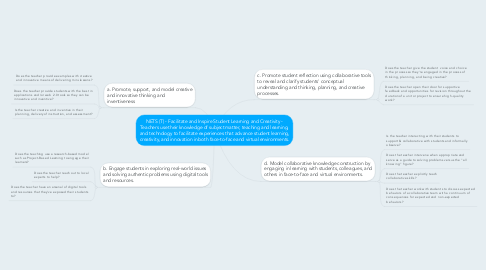NETS (T) - Facilitate and Inspire Student Learning and Creativity - Teachers use their knowledge of subject matter, teaching and learning, and technology to facilitate experiences that advance student learning, creativity, and innovation in both face-to-face and virtual environments.
by William Corcoran

1. a. Promote, support, and model creative and innovative thinking and inventiveness
1.1. Does the teacher provide examples with creative and innovative means of delivering mini-lessons?
1.2. Does the teacher provide students with the best in applications and/or web 2.0 tools so they can be innovative and inventive?
1.3. Is the teacher creative and inventive in their planning, delivery of instruction, and assessment?
2. b. Engage students in exploring real-world issues and solving authentic problems using digital tools and resources.
2.1. Does the teaching use a research-based model such as Project-Based Learning to engage their learners?
2.2. Does the teacher reach out to local experts to help?
2.3. Does the teacher have an arsenal of digital tools and resources that they've exposed their students to?
3. c. Promote student reflection using collaborative tools to reveal and clarify students' conceptual understanding and thinking, planning, and creative processes.
3.1. Does the teacher give the student voice and choice in the process so they're engaged in the process of thinking, planning, and being creative?
3.2. Does the teacher open their door for supportive feedback and opportunities for revision throughout the duration of a unit or project to ensure high-quality work?
4. d. Model collaborative knowledge construction by engaging in learning with students, colleagues, and others in face-to-face and virtual environments.
4.1. Is the teacher interacting with their students to support & collaborative with students and informally observe?
4.2. Does the teacher intervene when appropriate and serve as a guide to solving problems versus the "all knowing" figure?
4.3. Does the teacher explicitly teach collaborative skills?
4.4. Does the teacher work with students to discuss expected behaviors of a collaborative team with a continuum of consequences for expected and non-expected behaviors?



